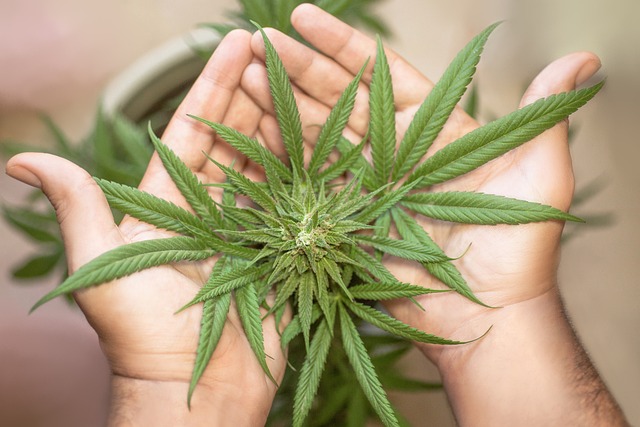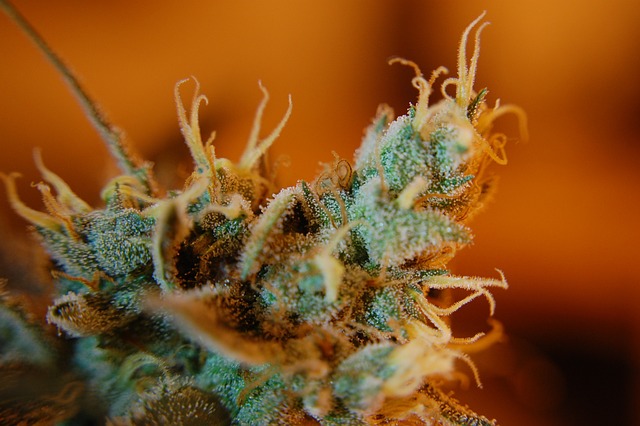The article examines the therapeutic properties of THCA flower, a non-psychoactive compound found in raw cannabis that converts to psychoactive THC when heated. It highlights how THCA’s effects are distinct from those of THC and the crucial role terpenes like myrcene and limonene play in enhancing its aroma, taste, and therapeutic efficacy. These terpenes not only influence the way cannabinoids are absorbed and metabolized but also contribute to the entourage effect, a phenomenon where the combined actions of these compounds create effects more powerful than their individual contributions. The article underscores the importance of understanding this interplay for users to fully harness THCA flower’s potential therapeutic benefits while being cautious of its side effects, which can range from mild reactions like dry mouth and eyes to more severe ones like anxiety or paranoia, especially with higher doses or potent strains. Users are advised to start with low dosages, consult strain-specific information, and monitor personal sensitivity to optimize the therapeutic advantages while minimizing adverse effects. Responsible consumption and proper sourcing are emphasized for a positive experience with THCA flower.
Exploring the complex interplay of terpenes and cannabinoids within THCA flower, this article sheds light on the multifaceted effects of this cannabinoid precursor. As we delve into its potential side effects, a nuanced understanding emerges, highlighting the importance of discerning individual sensitivity and usage context. Join us as we navigate the intricacies of high THCA flower, ensuring a well-rounded perspective on its therapeutic and experiential implications.
- Unraveling the Effects of THCA Flower: A Deep Dive into Terpenes and Cannabinoids
- Navigating the Potential Side Effects of THCA Flower Consumption: An In-Depth Analysis
Unraveling the Effects of THCA Flower: A Deep Dive into Terpenes and Cannabinoids

Unraveling the effects of THCA flower necessitates a comprehensive examination of its constituent components, particularly terpenes and cannabinoids. Tetrahydrocannabinolic acid (THCA), the precursor to the well-known psychoactive compound THC, exists naturally in raw cannabis plants. When heated or decarboxylated, THCA converts to THC, but prior to this transformation, it exhibits distinct properties separate from its psychoactive counterpart. The presence of a diverse array of terpenes in the THCA flower enhances its effects; these aromatic compounds not only contribute to the plant’s scent and flavor profiles but also play a pivotal role in modulating the therapeutic potential of the cannabinoids. For instance, myrcene is known for its sedative properties, while limonene is associated with mood-elevating effects. These interactions are complex, as terpenes can influence the absorption and metabolism of cannabinoids, thereby affecting their therapeutic impact. Research into the entourage effect highlights the synergistic relationship between these compounds, suggesting that the combined action of THCA and its accompanying terpene profile is more potent than the individual effects of each component. As such, understanding the intricate interplay between THCA flower’s terpenes and cannabinoids is crucial for comprehending its full spectrum of effects and potential therapeutic applications.
Navigating the Potential Side Effects of THCA Flower Consumption: An In-Depth Analysis

Consumption of THCA flower, which contains tetrahydrocannabinolic acid, a non-psychoactive precursor to THC, has garnered attention for its potential therapeutic properties. As with any substance that interacts with the human endocannabinoid system, it is imperative to understand the potential side effects associated with THCA flower. The efficacy and safety of THCA are believed to stem from its unique terpene and cannabinoid profile. These compounds work synergistically to modulate various physiological processes, but they can also elicit mild side effects in some individuals. Commonly reported side effects include dry mouth and dry eyes, which are generally considered benign and transient. Additionally, some users may experience anxiety or paranoia, particularly at higher doses or with higher potency strains, due to the psychoactive properties of THC that can convert from THCA upon heating or decarboxylation. It is crucial for consumers to approach THCA flower with caution and to start with low dosages to gauge individual sensitivity. Understanding the terpene and cannabinoid content of the specific strain being used can provide insights into potential side effects and help users make informed decisions about consumption methods and dosages. Regular monitoring of personal response to THCA flower, coupled with proper sourcing and usage guidelines, can mitigate risks and enhance the positive experiences associated with its therapeutic use.
Through a comprehensive examination of THCA flower’s terpenes and cannabinoids, the article sheds light on the complex interactions within this botanical compound. It is clear that while THCA flower can offer therapeutic benefits, it is not without its side effects. A prudent approach to its consumption involves understanding these potential impacts, which include but are not limited to psychoactive effects and gastrointestinal distress. Users should approach THCA flower with awareness and personal responsibility, considering individual physiology and the specific terpene and cannabinoid profiles present in each strain. As research continues to evolve, staying informed through credible sources remains vital for safe and effective use of THCA flower and its derivatives.
